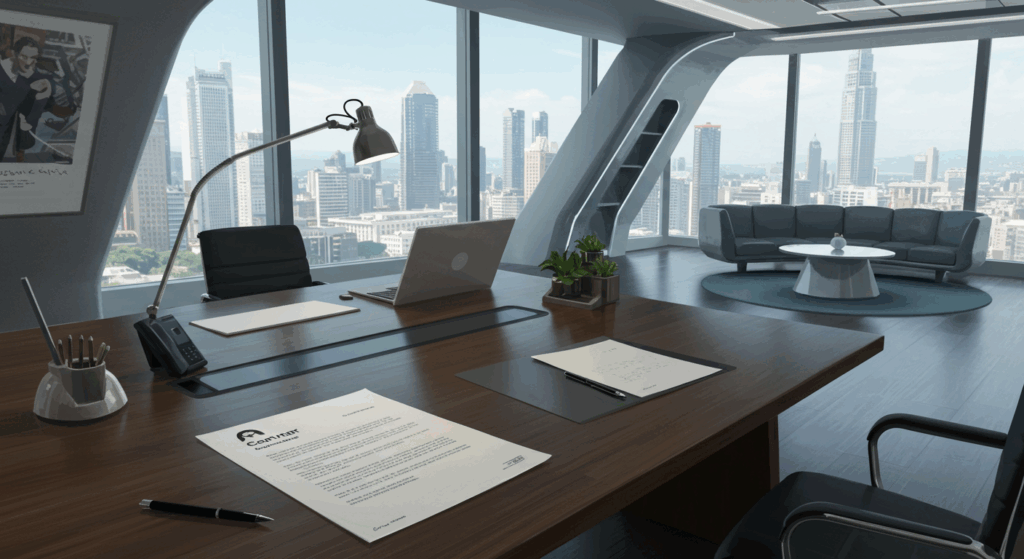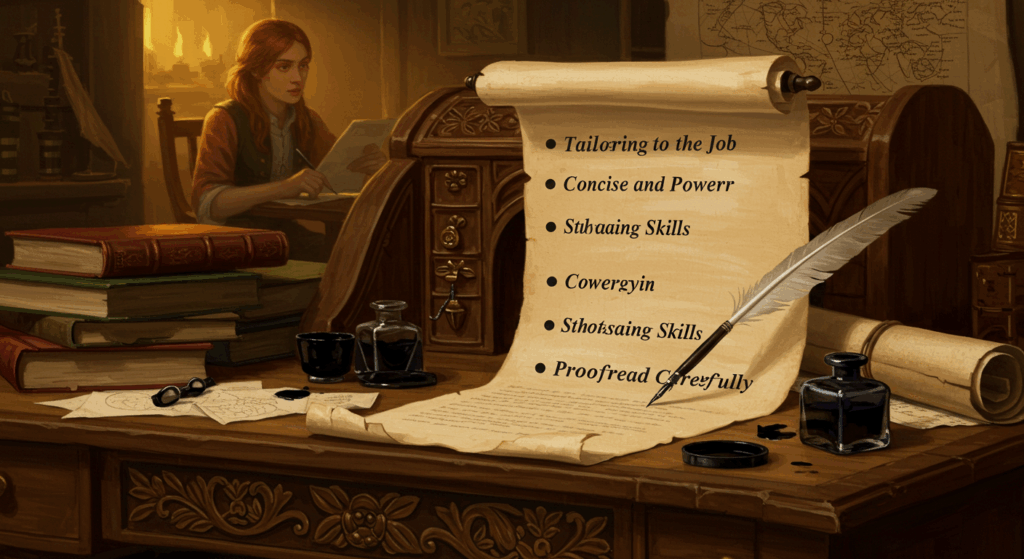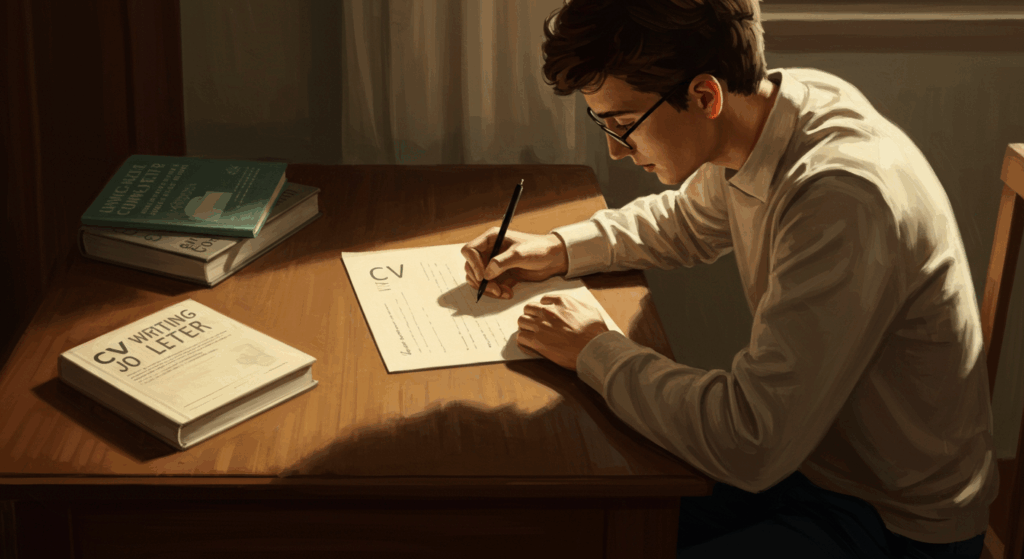So you’re staring at your laptop, resume polished, Spotify playing in the background, iced coffee sweating all over your desk… and then you hit that dreaded line in the application: “Upload Cover Letter.”
Cue the collective sigh.
I get it. Cover letters feel like the group project nobody asked for. You already spent hours trimming your resume into something sleek, and now they want you to write more? Like… haven’t you proven enough already?
But here’s the thing (and I hate that it’s true): cover letters can actually help you land interciews. They’re not just extra homework—they’re your chance to give personality and context to the bullet points on your resume. Think of your resume as your Tinder profile (photos + stats). The cover letter? That’s the actual conversation starter.
So if you’ve been putting this off, let me hold your hand (metaphorically, unless you’re into that). We’ll go step by step, I’ll throw in some job-specific tips, examples, and format hacks, and by the end you’ll be like, “Huh. That wasn’t so bad.”
Let’s go.
Why Cover Letters Still Matter (Even in 2025)
Here’s the deal: not every company asks for a cover letter. Some even make it “optional.” And ngl, sometimes we see “optional” and immediately hit “skip.” But think of it like online dating. Sure, you could have a blank profile, but would you swipe right on someone with just a blurry bathroom selfie and no bio? Exactly.
Cover letters give you a chance to:
- Show why you want the job (not just a job).
- Explain stuff your resume can’t (like job gaps, career changes, or your obsession with Excel spreadsheets).
- Prove you can actually write in a professional(ish) tone.
- Add a little personality so you don’t blend in with the 100 other applicants.
And sometimes, recruiters admit they’ll interview someone because their cover lettwer made them stand out. So yeah—it matters.
The Real World Step by Step Guide
Step 1: Stalk (Uh, Research) the Company
Before you type anything, you need intel. Cover letters are strongest when they feel like they were written for that one company, not mass-mailed to 20 places.
So do a lil’ digital stalking:
- Skim their About page—what’s their mission, values, or vibe?
- Check their social media—how do they talk about themselves? Are they buttoned-up, or more playful?
- Peek at their recent projects or news—anything exciting you can mention?
- If you’re brave, look up the hiring manager on LinkedIn (not creepy, promise—it’s normal).
Pro tip: keep a doc with notes on each company you apply to. That way you’re not scrambling every time.
Step 2: Format Without Stress
People overthink the cover letter format like it’s rocket science. It’s really not. Just keep it neat and readable. Here’s the classic structure:
- Header with your info (name, phone, email, LinkedIn link).
- Date + company info (yes, like an old-school letter).
- Greeting (ideally “Dear [Hiring Manager’s Name],” but if you don’t know, “Dear Hiring Team” works fine).
- Intro paragraph (grab attention—why this job, why them).
- Body paragraph(s) (your skills + examples connected to the job).
- Closing paragraph (thanks + call to action).
- Signature (your name, maybe your phone/email again).
One page max. Font size 11–12. Save as PDF so it doesn’t get weird formatting on their end. Done.
Step 3: Don’t Start Boring
If your first line is “I am writing to express my interest in the [Job Title] possition at [Company],” …congrats, you just bored the recruiter to sleep.
Try these instead:
Bad opener:
“I am writing to apply for the Marketing Coordinator role at XYZ Company.”
Better opener (example 1):
“As someone who has rewatched The Office more times than I care to admit, I know a thing or two about dry corporate comms—and more importantly, how to make them less boring. That’s exactly why I’m excited about the Marketing Coordinator role at XYZ Company.”
Better opener (example 2):
“When I saw your company’s TikTok campaign about sustainable fashion blow up with over 2 million views, I thought: yep, these are my people. As a content creator with a knack for trend-spotting, I’d love to help you keep that momentum going.”
See the difference? You’re already showing personality and making it relevant to the company.
Step 4: The Body (Connect Your Story to Their Needs)
This is the meat of the letter. And no, it’s not just “copy-paste your resume in paragraph form.” It’s about connecting the dots.
Here’s a mini formula:
- Pick 2–3 key skills or experiences from your resume.
- Match them to something in the job description.
- Use an example or tiny story to prove it.
Example – Basic (meh):
“I have strong organizational skills and experience managing projects.”
Example – Strong (with detail):
“In my last role, I coordinated a product launch across three departments, keeping everyone on schedule and under budget. The result? A 25% increase in sales that quarter. I’d love to bring that same project management energy to your team.”
The second one actually shows results. That’s what recruiters want.
Job-Specific Tips, Examples, Format Hacks
- Changing careers? Translate your old skills. “My years in retail taught me how to stay calm under pressure and deliver top-tier customer service, which I know is key in this client-facing role.”
- No experience? Lean on school projects, volunteering, or even side hustles. “As a volunteer social media manager for a local nonprofit, I grew our Instagram following by 300% in six months.”
- Creative jobs? You can be a little playful, but don’t turn it into stand-up comedy.
- Corporate jobs? Keep it professional, but don’t suck the life out of it. Even bankers appreciate a sentence that feels human.
Step 5: End Like a Pro (Not Weird)
The ending is simple:
- Thank them for their time.
- Reaffirm your interest.
- Politely nudge toward an interview.
Bad closing:
“Thank you for your time and consideration. I look forward to hearing from you.”
Better closing:
“Thanks so much for considering my application. I’d be thrilled to bring my blend of creativity and strategy to the team at XYZ Company, and I’d love the chance to talk more about how I can contribute.”
It’s short, polite, and leaves the door open.
Common Mistakes (Don’t Do These)
- Being generic. Recruiters can spot a copy-paste job a mile away.
- Writing a novel. One page. That’s it.
- Overly formal tone. You’re not writing to a medieval king.
- Overly casual tone. “Yo fam hire me” is not it.
- Forgetting to proofread. Typos happen, but a sloppy letter screams “I don’t care.”
- Repeating your resume word-for-word. The cover letter should add, not duplicate.
Quick Job-Specific Examples
Here are some mini snippets you can steal inspiration from:
For a marketing job:
“When I noticed your recent campaign highlighting mental health awarenesss, I immediately connected with it. As someone who’s led initiatives around wellness at my current role, I’d love to help your team build campaigns that resonate deeply with audiences.”
For a tech role:
“While debugging code at 2 a.m. isn’t everyone’s idea of fun, I kind of live for it. In my internship at [Company], I reduced page load times by 40% by optimizing backend scripts. I’d love to bring that problem-solving energy to your dev team.”
For an entry-level job:
“As a recent graduate with a degree in Communications, I may not have years of professional experience yet, but I’ve built strong skills through managing my university’s podcast, where I grew the audience from 200 to 2,000 listeners.”
Good vs. Bad: A Side-by-Side Snippet
Bad (generic):
“I am hardworking, detail-oriented, and a team player. I believe I would be a good fit for your company.”
Good (specific):
“During my role at [Company], I managed a five-person team through a product launch. By tracking every detail (and yes, every tiny spreadsheet cell), we not only hit our deadline but beat it by two weeks. That experience taught me how to blend detail orientation with teamwork, something I’d love to bring to this role.”
Specifics always win.
How to Add Personality Without Going Overboard
This is a balancing act. You don’t want to be so stiff you sound like ChatGPT circa 2021, but you also don’t want to overshare like it’s your finsta.
Do:
- Drop a fun line that shows you’re human (“yes, I’m that person who color-codes their Google Calendar for fun”).
- Mention why you genuinely care about the role or company.
- Write like you’d talk in a professional meeting.
Don’t:
- Use slang every other word.
- Get too personal (like, no need to talk about your breakup unless you’re applying for a Taylor Swift thinkpiece gig).
- Try too hard to be funny.
Cover Letter Format Checklist
Before you hit “submit,” double-check:
- One page, max.
- Standard font (Calibri, Arial, Times—don’t get weird).
- Consistent margins.
- PDF format.
- Greeting personalized if possible.
- Proofread once, then proofread again.
Sample Cover Letter (Ready to Use)
[Your Name]
[Your Address]
[City, State, Zip]
[Your Email] • [Your Phone] • [LinkedIn URL]
[Date]
[Hiring Manager’s Name]
[Company Name]
[Company Address]
[City, State, Zip]
Dear [Hiring Manager’s Name],
When I saw the posting for the [Job Title] role at [Company], I knew I had to apply. Not only do I admire the way your team [something specific about the company—like their mission, product, or campaign], but I also bring the skills and energy you’re looking for.
In my previous role at [Previous Company], I [insert achievement—ex: “grew social engagement by 120% in six months by creating trend-driven campaigns that still stayed true to the brand voice”]. That experience taught me how to balance creativity with analytics, which I know is key for success in this position.
Beyond metrics, I thrive in collaborative environments. For example, I partnered with cross-functional teams on [project], ensuring deadlines were met and results exceeded expectations. I’m confident those same skills—clear communication, organization, and adaptability—would help me contribute quickly at [Company].
I’d be excited to bring my background in [your field/skills] and my passion for [industry/mission] to your team. Thank you so much for considering my application. I’d love the chance to discuss how my experience can support [Company]’s goals.
Sincerely,
[Your Name]
Real Talk: Why This Feels Hard
Look, writing about yourself is awkward. You don’t want to sound braggy, but you also don’t want to undersell. My trick? Pretend you’re writing about your best friend. If your friend grew a TikTok following, you’d hype them up like crazy. Do that for yourself—just… in a professional way.
Final Takeaway
Cover letters are basically your shot at saying, “Hey, I’m not just a list of skils—I’m a whole person who actually wants this job.” And in today’s job market, that matters.
So next time you see that “Upload Cover Letter” field, don’t roll your eyes (well, okay, you can roll them a little). But then, take 30 minutes, personalize it, throw in some examples, and hit send. You’ll be miles ahead of the people who phoned it in.
Trust me, you got this. And who knows? The letter you almost didn’t write might be the one that lands you the interview.
Now go crush it. ✨









